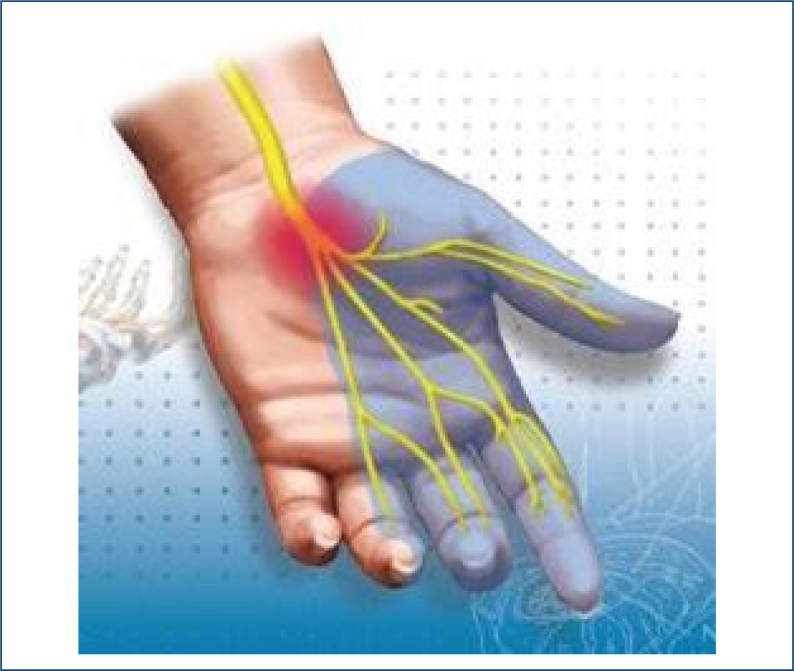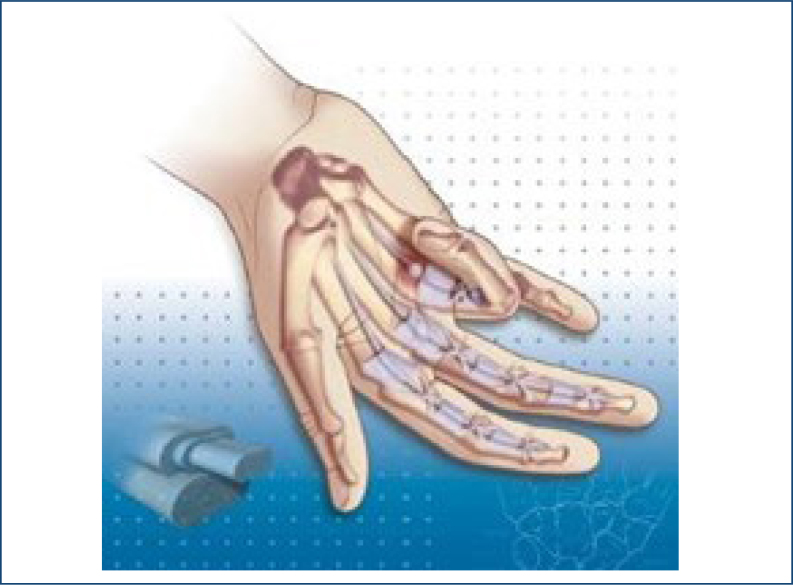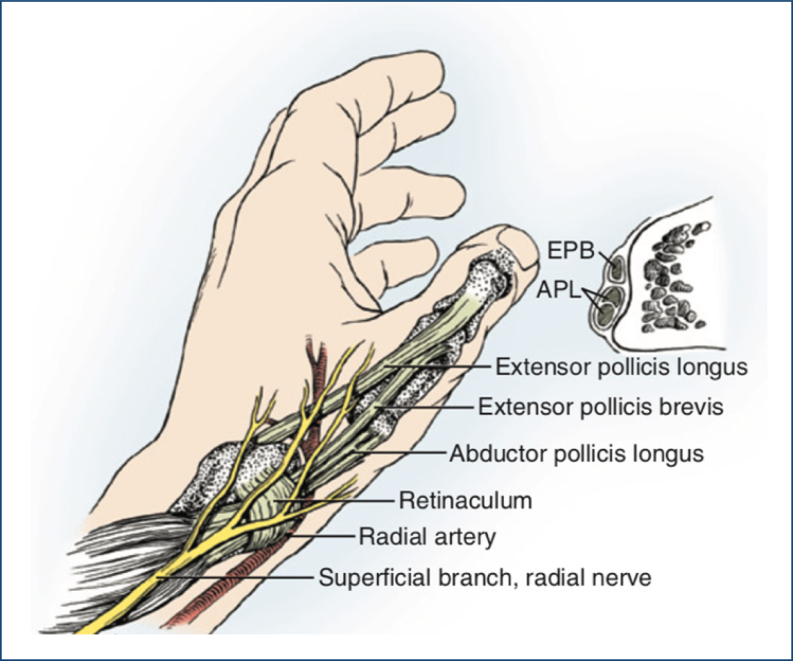INTRODUCTION
Women represent more than 50% of the Brazilian population and deserve special health care. Due to their caring and organizing nature, they often have a double shift, at work and at home, taking care of their children, other family members, and even members of the community where they live 1 . The hand is the human's main tool, an extension of the brain, playing a critical role, especially in women. It is a work, care, affection, expression, and support tool.
Although women have more diseases than men and seek for care more frequently, they statistically live longer than men 2 and, therefore, have more conditions that are typical of aging, such as arthroses, which can affect many areas of the body, including the hands.
Women's hormone pattern is very different from men's 3 , with sudden changes in pregnancy, puerperium, and menopause, in whom the changes are more pronounced than in men. These changes favor specific disorders in the upper limbs, such as compressive syndromes and tenosynovitides.
In this article, we will highlight the main conditions that more frequently affect women in our specialty hand surgery.
IN THE MEDICAL FIELD
Female surgeons and interventionists experienced more musculoskeletal pain in the upper limbs than male counterparts. Some of the characteristics found in the studies were that women were generally shorter, wore smaller glove sizes, and were younger than their male counterparts. Furthermore, the size and design of the instruments and equipment handled by physicians are developed to meet the characteristics of the man's hand rather than the woman's for performing the same procedure 4,5 . We believe that such elements of harm to the health of the upper limbs in women may be present in several other occupations.
CARPAL TUNNEL SYNDROME
Carpal tunnel syndrome is the most common compressive peripheral neuropathy, which affects up to 1% of the general population 6 . It is characterized by compression of the median nerve at the wrist, inside the carpal tunnel, through which nine flexor tendons of the fingers and thumb also pass (Figure 1).
Figure 1. Graphical representation of the carpal tunnel with the presence of the median nerve and its ramifications to the fingers.
It affects more women in the climacteric period due to hormonal changes 6 . The patient reports tingling in the hands, at first only during the night or in some specific activities, until symptoms become continuous. As the condition worsens, the sensitivity of the fingers decreases and there is a loss of grip strength in the hand, more selectively in the thumb. Initially, we treat with medication, orthoses, hand therapy, and hormonal correction. In patients with severe compression or in cases of failure of conservative treatment, we indicate surgical treatment, which can be performed using the open or endoscopic method.
TRIGGER FINGER
Trigger finger is caused by the friction of the flexor tendons on the pulleys, mainly the A1 pulley, located at the base of the finger, at the level of the metacarpophalangeal joint, resulting in an inflammatory process called stenosing tenosynovitis (Figure 2). It is one of the most frequent affections in our specialty. It is more frequent in women after the fourth decade of life 7 , and the most affected fingers are the thumb, middle, and ring fingers.
Figure 2. Graphical representation of the trigger ring finger, showing a nodule in the flexor tendon and the A1 pulley.
Treatment is based on rest, anti-inflammatory medication, orthoses, steroid injections, and, when clinical treatment fails, surgery using the conventional open method or needle tenolysis, both with good results.
DE QUERVAIN’S STENOSING TENOSYNOVITIS
De Quervain's stenosing tenosynovitis is an inflammatory process located on the lateral aspect of the wrist, just above the thumb, which affects the tendons of the abductor pollicis longus and extensor pollicis brevis muscles, which cross an osteofibrous tunnel where they get inflamed due to friction (Figure 3). It preferably affects women in a ratio of 3:1 8 . It is often associated with hormonal changes 9 and vicious positions with the wrist, and flexion and ulnar deviation, exactly the position adopted by mothers during breastfeeding, bathing, and the act of removing the baby from the crib or stroller.
Figure 3. Anatomy of the lateral aspect of the wrist and hand, showing the first tunnel of the extensors and their anatomical relationships. EPB: extensor pollicis brevis; APL: abductor pollicis longus.
Treatment consists of correcting posturing and the hormonal profile, hand therapy, use of orthoses, and infiltration with corticosteroids, bearing the difficulty of the puerperal woman in mind, when she has to leave home to undergo hand therapy and leave her small child and perform the multiple mother functions with the use of orthoses. In cases where clinical treatment fails, surgery to decompress the extensor tunnel I is indicated.
RHEUMATIC DISEASES
Rheumatic diseases often affect the hand and wrist, causing deformities and destruction of the joint and tendon and capsuloligamentous structures. Unlike gout and ankylosing spondylitis, among others, rheumatoid arthritis and osteoarthritis commonly affect women 10 . The most common features are deformities in the fingers, with rheumatoid arthritis frequently affecting the proximal interphalangeal joints (Bouchard's node), while arthrosis preferentially affects the distal interphalangeal joints. The treatment is multidisciplinary, and the hand surgeon is responsible for preventing deformities through synovectomy and, when the deformities are already present, performing various corrective procedures, arthrodesis, and joint prostheses.
ARTHROSIS
Hands and wrists arthrosis mainly affects two regions: the distal interphalangeal joints of the fingers and the trapeziometacarpal joint of the thumb. With regard to sex, it affects women three times more than men 11 .
Trapeziometacarpal arthrosis, also known as rhizarthrosis, can have a degenerative, inflammatory, traumatic, or idiopathic origin. It is a frequent condition, especially in women after the fifth decade of life, which causes weakness, pain, and deformity in the thumb, generating disability and a negative impact on the performance of daily and work activities. After the age of 55 years, rhizarthrosis affects 33% of women and 11% of men 12 . Initially, the joint becomes painful, and in the final stage, complaints of joint stiffness and deformity of the thumb in adduction arise.
Treatment consists of anti-inflammatory medication, orthoses, hand therapy, infiltration, and surgery in cases that do not respond to clinical treatment.
Arthrosis of the distal interphalangeal joints, which are the ones closest to the fingertips, causes a progressive, albeit slow, increase in volume and deformation of the joint (Heberden's nodes) with the appearance of occasional translucent mucous cysts. They are limiting because of the deformity and, mainly, of pain. It is usually clinically treated due to the lower potential for functional impairment compared to rhizarthrosis and, occasionally, surgically treated in refractory cases 13 .
OCCUPATIONAL DISEASES
The demands of work for both sexes are usually similar, despite the bodily difference. Another factor is adaptation after a certain age, where postmenopausal changes are more evident in women 14 . Tenosynovitides and compressive syndromes, as mentioned before, are generally more common in women and in the postmenopausal period.
FRACTURE OF THE DISTAL END OF THE RADIUS
The radius is the most fractured bone in the human body, accounting for approximately 18% of fractures 15 , and is considered a sentinel fracture, which indicates an osteoporotic process. Osteoporosis is described as a microstructural degenerative process of the bone that leads to a decrease in bone mass, leading to bone fragility. Over the years, there is an increase in osteoporosis and a consequent increase in the incidence of fractures. Women after menopause, due to estrogen deficiency, are twice as likely to have fractures of the end of the radius 16 . The worse the bone quality, the greater the fracture comminution and the more unstable the fracture, requiring surgical treatment. There are many possibilities for surgical treatment, with plate and screw fixation being the most popular method 17 .
FIBROMYALGIA
Another condition that virtually affects the entire body, including the hands and wrists, is fibromyalgia. Often, due to the rich clinical picture, it simulates many common affections of the upper limbs. It is a condition with a multidisciplinary approach, which is much more frequent in women, representing 80–90% of cases 18 .
COMPLEX REGIONAL PAIN SYNDROME/REFLEX SYMPATHETIC DYSTROPHY
Complex regional pain syndrome, which is also known as reflex sympathetic dystrophy, is a not very frequent complication, but with very bad consequences after surgical treatment of affections of the hands or even after trauma to the hand or wrist. It is as if the organism had a disproportionate response, much greater than the tissue aggression would require. The affected limb becomes edematous and painful, with changes in trophism and skin color. It is more common in women in the fifth decade of life and is probably related to the emotional state 19 . The treatment of this condition is a great challenge for us. It shall be addressed by a multidisciplinary team that includes a hand surgeon, a pain specialist, a physiotherapist, a hand therapist, and a psychotherapist 20 .
Finally, the hand surgeon shall often differentiate and individualize the treatment when the patient is a woman, due to her different demands, her physiological pattern, and her social role.
Footnotes
Funding: none.
Brazilian Society of Hand Surgery
REFERENCES
- 1.Ristori J, Cocchetti C, Romani A, Mazzoli F, Vignozzi L, Maggi M, et al. Brain sex differences related to gender identity development: genes or hormones? Int J Mol Sci. 2020;21(6):2131–2131. doi: 10.3390/ijms21062123. [DOI] [PMC free article] [PubMed] [Google Scholar]
- 2.Austad SN, Fischer KE. Sex differences in lifespan. Cell Metab. 2016;23(6):1022–1033. doi: 10.1016/j.cmet.2016.05.019. [DOI] [PMC free article] [PubMed] [Google Scholar]
- 3.Tokatli MR, Sisti LG, Marziali E, Nachira L, Rossi MF, Amantea C, et al. Hormones and sex-specific medicine in human physiopathology. Biomolecules. 2022;12(3):413–413. doi: 10.3390/biom12030413. [DOI] [PMC free article] [PubMed] [Google Scholar]
- 4.Bellini MI, Amabile MI, Saullo P, Zorzetti N, Testini M, Caronna R, et al. A woman's place is in theatre, but are theatres designed with women in mind? A systematic review of ergonomics for women in surgery. J Clin Med. 2022;11(12):3496–3496. doi: 10.3390/jcm11123496. [DOI] [PMC free article] [PubMed] [Google Scholar]
- 5.Dahlgren G, Liv P, Öhberg F, Slunga Järvholm L, Forsman M, Rehn B. Ratings of hand activity and force levels among women and men who perform identical hand-intensive work tasks. Int J Environ Res Public Health. 2022;19(24):16706–16706. doi: 10.3390/ijerph192416706. [DOI] [PMC free article] [PubMed] [Google Scholar]
- 6.Balcerzak AA, Ruzik K, Tubbs RS, Konschake M, Podgórski M, Borowski A, et al. How to differentiate pronator syndrome from carpal tunnel syndrome: a comprehensive clinical comparison. Diagnostics (Basel) 2022;12(10):2433–2433. doi: 10.3390/diagnostics12102433. [DOI] [PMC free article] [PubMed] [Google Scholar]
- 7.Kang HP, Vakhshori V, Mohty K, Azad A, Lefebvre R. Risk factors associated with progression to surgical release after injection of trigger digits. J Am Acad Orthop Surg Glob Res Rev. 2021;5(7):e20.00159. doi: 10.5435/JAAOSGlobal-D-20-00159. [DOI] [PMC free article] [PubMed] [Google Scholar]
- 8.Hassan K, Sohn A, Shi L, Lee M, Wolf JM. De Quervain tenosynovitis: an evaluation of the epidemiology and utility of multiple injections using a national database. J Hand Surg Am. 2022;47(3):284.e1–284.e6. doi: 10.1016/j.jhsa.2021.04.018. [DOI] [PubMed] [Google Scholar]
- 9.Ippolito JA, Hauser S, Patel J, Vosbikian M, Ahmed I. Nonsurgical treatment of De Quervain tenosynovitis: a prospective randomized trial. Hand. 2020;15(2):215–219. doi: 10.1177/1558944718791187. [DOI] [PMC free article] [PubMed] [Google Scholar]
- 10.Anagnostopoulos I, Zinzaras E, Alexiou I, Papathanasiou AA, Davas E, Koutroumpas A, et al. The prevalence of rheumatic diseases in central Greece: a population survey. BMC Musculoskelet Disord. 2010;11:98–98. doi: 10.1186/1471-2474-11-98. [DOI] [PMC free article] [PubMed] [Google Scholar]
- 11.Reginster JYL, Arden NK, Haugen IK, Rannou F, Cavalier E, Bruyère O, et al. Guidelines for the conduct of pharmacological clinical trials in hand osteoarthritis: Consensus of a Working Group of the European Society on Clinical and Economic Aspects of Osteoporosis, Osteoarthritis and Musculoskeletal Diseases (ESCEO) Semin Arthritis Rheum. 2018;48(1):1–8. doi: 10.1016/j.semarthrit.2017.12.003. [DOI] [PMC free article] [PubMed] [Google Scholar]
- 12.Wolfe SW, Pederson WC, Kozin SH, Cohen MS. Green's operative hand surgery e-book. Elsevier Health Sciences; 2021. pp. 2400–2400. [Google Scholar]
- 13.Wu JC, Calandruccio JH, Weller WJ, Henning PR, Swigler CW. Arthritis of the thumb interphalangeal and finger distal interphalangeal joint. Orthop Clin North Am. 2019;50(4):489–496. doi: 10.1016/j.ocl.2019.05.004. [DOI] [PubMed] [Google Scholar]
- 14.Gignac MAM, Ibrahim S, Smith PM, Kristman V, Beaton DE, Mustard CA. The role of sex, gender, health factors, and job context in workplace accommodation use among men and women with arthritis. Ann Work Expo Health. 2018;62(4):490–504. doi: 10.1093/annweh/wxx115. [DOI] [PMC free article] [PubMed] [Google Scholar]
- 15.Ochen Y, Peek J, Velde D, Beeres FJP, Heijl M, Groenwold RHH, et al. Operative vs nonoperative treatment of distal radius fractures in adults: a systematic review and meta-analysis. JAMA Netw Open. 2020;3(4):e203497. doi: 10.1001/jamanetworkopen.2020.3497. [DOI] [PMC free article] [PubMed] [Google Scholar]
- 16.Zhou S, Tao Z, Zhu Y, Tao L. Mapping theme trends and recognizing hot spots in postmenopausal osteoporosis research: a bibliometric analysis. PeerJ. 2019;7:e8145. doi: 10.7717/peerj.8145. [DOI] [PMC free article] [PubMed] [Google Scholar]
- 17.Huang YM, Chen CY, Lin KC, Tarng YW, Liao CY, Chang WN. Functional outcomes following fixation of a marginal distal radius fracture with two commonly used volar locking plates: a retrospective cohort study. BMC Musculoskelet Disord. 2022;23(1):18–18. doi: 10.1186/s12891-021-04984-1. [DOI] [PMC free article] [PubMed] [Google Scholar]
- 18.Wolfe F, Walitt B, Perrot S, Rasker JJ, Häuser W. Fibromyalgia diagnosis and biased assessment: sex, prevalence and bias. PLoS One. 2018;13(9):e0203755. doi: 10.1371/journal.pone.0203755. [DOI] [PMC free article] [PubMed] [Google Scholar]
- 19.Halicka M, Vittersø AD, McCullough H, Goebel A, Heelas L, Proulx MJ, et al. Prism adaptation treatment for upper-limb complex regional pain syndrome: a double-blind randomized controlled trial. Pain. 2021;162(2):471–489. doi: 10.1097/j.pain.0000000000002053. [DOI] [PMC free article] [PubMed] [Google Scholar]
- 20.Eldufani J, Elahmer N, Blaise G. A medical mystery of complex regional pain syndrome. Heliyon. 2020;6(2):e03329. doi: 10.1016/j.heliyon.2020.e03329. [DOI] [PMC free article] [PubMed] [Google Scholar]





